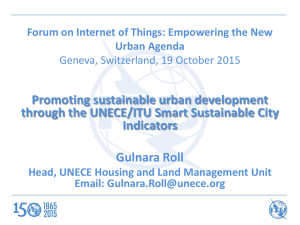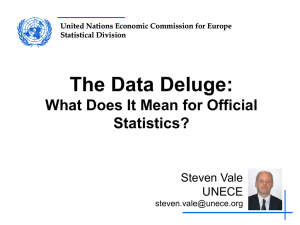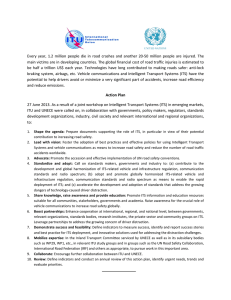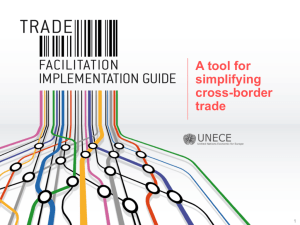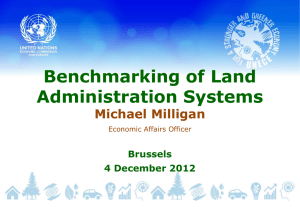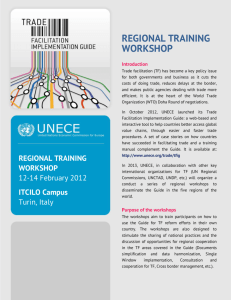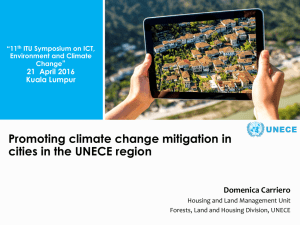United Nations Economic Commission for Europe Transport Division
advertisement
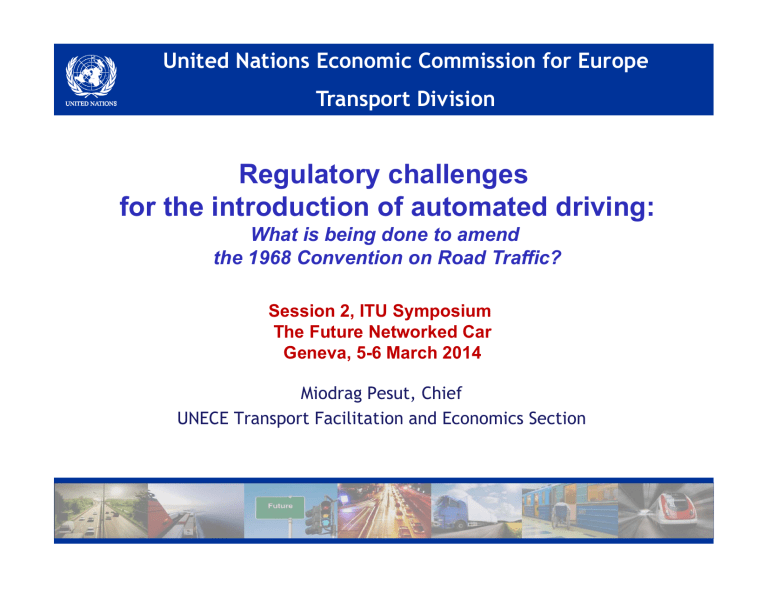
United United Nations Nations Economic Economic Commission Commission for for Europe Europe Transport Transport Division Division Regulatory challenges for the introduction of automated driving: What is being done to amend the 1968 Convention on Road Traffic? Session 2, ITU Symposium The Future Networked Car Geneva, 5-6 March 2014 Miodrag Pesut, Chief UNECE Transport Facilitation and Economics Section Presentation Objectives 1. 2. 3. 4. Background on UNECE and our road safety work WP.1 and WP.29 Key road safety-related international conventions "Driver Assistance Systems" and Article 8 of the 1968 Convention on Road Traffic 5. What is being done to amend Article 8 6. Current status 7. Remaining agenda Schneuwly UNECE -Jean-Claude Transport Division Slide 2 UNECE - 60 years of road safety work Social legislation for professional drivers Road Traffic Rules (driving times and rest periods) Road Signs and Signals Vehicle Regulations Dangerous Goods Infrastructure (standards and parameters, tunnel safety, all land modes) Statistics Schneuwly UNECE -Jean-Claude Transport Division Slide 3 Road Safety at a 360 degree approach • Regulatory work To ensure widest possible geographical coverage of UN road safety international legal instruments • Policy dialogue To strengthen road safety management and coordination • Analytical work To assist in the identification of best practices • Technical Assistance To assist countries in the ECE region and beyond to implement the UN Decade of Action for Road safety http://www.unece.org/trans/wp1/publications/spectrum_road_ safety_activites.html Schneuwly UNECE -Jean-Claude Transport Division Slide 4 The two UNECE subsidiary bodies with a global road safety impact: WP.1 and WP.29 Working Party on Road Traffic Safety (WP.1) • • • the ONLY permanent intergovernmental body in the UN dealing with road safety open to all countries throughout the world responsible for administering the international road safety-related conventions including the 1968 Conventions on Road Traffic and Road Signs and Signals works in conjunction with WP.29 and other working parties to offer a platform that enables cooperation and the exchange of road safety information and best practices among governments World Forum for Harmonization of Vehicle Regulations (WP.29) • • • • UN body that develops and adopts harmonized vehicle regulations that can be applied worldwide research-based regulations promote the design and construction of safer and more environmentally-friendly vehicles to date, over 140 regulations have been developed (annexed to the 1958 and 1998 "Vehicle Regulations" Agreements) sets standards for periodical technical inspections Schneuwly UNECE -Jean-Claude Transport Division Slide 5 Key international legislation relating to road safety Main legal instruments • • • • • • • • Convention on Road Traffic, Vienna 1968 Convention on Road Signs and Signals, Vienna 1968 Agreement concerning the Adoption of Uniform Technical Prescriptions for Wheeled Vehicles, Equipment and Parts which can be fitted and /or be used on Wheeled Vehicles and the Conditions for Reciprocal Recognition of Approvals Granted on the Basis of these Prescriptions, of 20 March 1958 Agreement concerning the Adoption of Uniform Conditions for Periodical Technical Inspections of Wheeled Vehicles and the Reciprocal Recognition of Such Inspections, of 13 November 1997 Agreement concerning the Establishing of Global Technical Regulations for Wheeled Vehicles, Equipment and Parts which can be fitted and / or be used on Wheeled Vehicles, of 25 June 1998 European Agreement Concerning the Work of Crews of Vehicles Engaged in International Road Transport (AETR) European Agreement on Main International Traffic Arteries (AGR) European Agreement concerning the International Carriage of Dangerous Goods by Road (ADR) of 30 September 1957 Schneuwly UNECE -Jean-Claude Transport Division Slide 6 Article 8 of the 1968 Convention on Road Traffic Article 8 "Drivers" 1. Every moving vehicle or combination of vehicles shall have a driver. … 5. Every driver shall at times be able to control his vehicle or to guide his animals. How to appropriately amend the classic 1968 Convention on Road Traffic with rapidly changing technology covered by technical reuglations that has started to become available for use in vehicles? Schneuwly UNECE -Jean-Claude Transport Division Slide 7 What is being done to amend Art.8? To date, there has been no consensus within WP.1 as to what the amendment to Art.8, if any, should be. Discussion has ranged from: • No change • Refer to the technical vehicle regulations • Insert a new definition of "Driver Assistance Systems" Schneuwly UNECE -Jean-Claude Transport Division Slide 8 Current status In recent WP.1 sessions, a compromise proposal has been developed, and is in the process of being refined. The general shape of the compromise is a new clause referring to the technical regulations as well as including a broad definition of "Driver Assistance Systems". Schneuwly UNECE -Jean-Claude Transport Division Slide 9 United United Nations Nations Economic Economic Commission Commission for for Europe Europe Transport Transport Division Division Legislatures in the following states are considering or have considered bills related to automated driving Remaining agenda • • • • • Economic and social issues Legal issues Insurance law issues Managing autonomous transportation demand Collision between autonomous vehicles and the liability system • “But Officer, It Wasn’t My Fault, the Car Did It!” • Privacy and cybersecurity issues Schneuwly UNECE -Jean-Claude Transport Division Slide 11 Contact Us http://www.unece.org/trans/main/welcwp1.html Miodrag.Pesut@unece.org +41 (0) 22 917 41 36 Schneuwly UNECE -Jean-Claude Transport Division Slide 12
